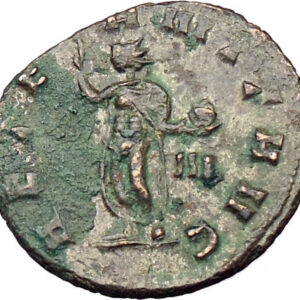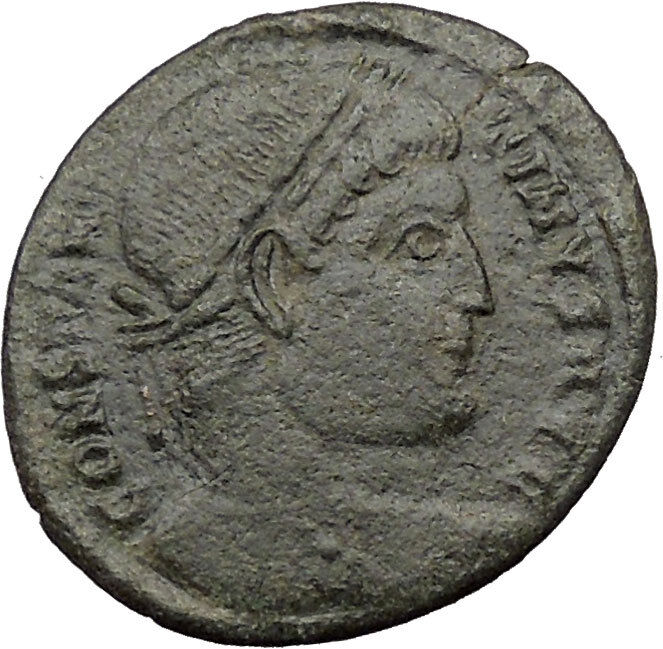|
Trajan
–
Roman Emperor
: 98-117 A.D. –
Silver Denarius 18mm (3.39 grams) Struck circa 101-102 A.D.
Reference: RIC 56b; Cohen 238. (RIC describes the coin as Felicitas with the
attributes
of Pax, as on RIC 6)
IMP CAES NERVA TRAIAN AVG GERM, laureate head right
P M TR P COS IIII P P, Felicitas or Pax standing left, holding branch &
cornucopia.
You are bidding on the exact item pictured,
provided with a Certificate of Authenticity and Lifetime Guarantee of
Authenticity.
Eirene, or Irene Greek for “peace”; the
Roman
equivalent was
Pax
, one of the
Horae
, was the personification of peace, and
was depicted in art as a beautiful young woman carrying a
cornucopia
,
sceptre
and a torch or
rhyton
. She is said sometimes to be the
daughter of Zeus
and
Themis
.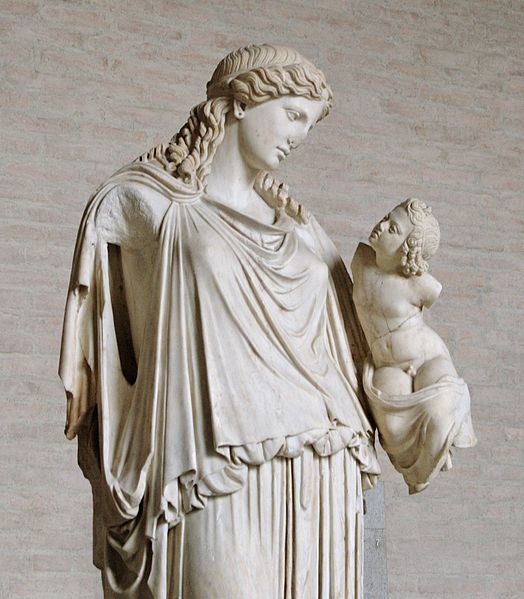
She was particularly well regarded by the
citizens of Athens
. After a naval victory over
Sparta
in 375 BC, the Athenians established a
cult for Eirene, erecting
altars
to her. They held an annual state
sacrifice to her after 371 BC to commemorate the
Common Peace
of that year and set up a votive
statue in her honour in the
Agora of Athens
. The statue was executed in
bronze by
Cephisodotus the Elder
, likely the father or
uncle of the famous sculptor
Praxiteles
. It was acclaimed by the Athenians,
who depicted it on vases and coins.
Although the statue is now lost, it was copied in marble by the Romans; one
of the best surviving copies (right) is in the
Munich
Glyptothek
. It depicts the goddess carrying a
child with her left arm –
Ploutos
, the god of plenty and son of
Demeter
, the goddess of agriculture. Eirene’s
missing right hand once held a sceptre. She is shown gazing maternally at
Ploutos, who is looking back at her trustingly. The statue is an allegory for
Plenty (Ploutos) prospering under the protection of Peace (Eirene); it
constituted a public appeal to good sense. The copy in the Glyptothek was
originally in the collection of the
Villa Albani
in Rome but was looted and taken
to France by
Napoleon I
. Following Napoleon’s fall, the
statue was bought by
Ludwig I of Bavaria
.

In
Roman mythology
, Pax (Latin
for peace
) (her
Greek
equivalent was
Eirene
) was recognized as a
goddess
during the rule of
Augustus
. On the
Campus Martius
, she had a temple called the
Ara Pacis
, and another temple on the
Forum Pacis
. She was depicted in art with
olive
branches, a
cornucopia
and a scepter. There was a festival
in her honor on January 3. Daughter of
Jupiter
and
Iustitia
. Pax was often associated with spring.
In
ancient Roman culture
, felicitas
(from the Latin
adjective
felix, “fruitful, blessed,
happy, lucky”) is a condition of divinely inspired productivity, blessedness, or
happiness
. Felicitas could encompass
both a woman’s fertility, and a general’s luck or good fortune. The divine
personification of Felicitas was
cultivated
as a goddess. Although felicitas
may be translated as “good luck,” and the goddess Felicitas shares some
characteristics and attributes with
Fortuna
, the two were distinguished in
Roman religion
.Fortuna was unpredictable and
her effects could be negative, as the existence of an altar to Mala Fortuna
(“Bad Luck”) acknowledges.Felicitas, however, always had a positive
significance. She appears with
several epithets that focus on aspects of her divine power.
Felicitas had a temple in Rome as early as the mid-2nd century BC, and during
the Republican eraa
was honored at two
official festivals
of
Roman state religion
, on July 1 in conjunction
with
Juno
and October 9 as Fausta Felicitas.
Felicitas continued to play an important role in
Imperial cult
, and was frequently portrayed on
coins
as a symbol of the wealth and prosperity
of the Roman Empire
. Her primary attributes are the
caduceus
and
cornucopia
.The English word “felicity” derives
from felicitas.
As virtue or quality

Phallic
relief
with the inscription “Felicitas
dwells here”
In its religious sense, felix means “blessed, under the protection or
favour of the gods; happy.” That which is felix has achieved the
pax divom
, a state of harmony or peace with
the divine world. The word derives from
Indo-European
*dhe(i)l, meaning “happy,
fruitful, productive, full of nourishment.” Related Latin words include
femina, “woman” (a person who provides nourishment or suckles); felo,
“to suckle” in regard to an infant; filius, “son” (a person suckled); and
probably fello, fellare, “to perform
fellatio
“, with an originally non-sexual
meaning of “to suck”. The continued magical association of sexual potency,
increase, and general good fortune in productivity is indicated by the
inscription Hic habitat Felicitas (“Felicitas dwells here”)[8]
on an
apotropaic
relief of a
phallus
at a bakery in
Pompeii
.
In archaic Roman culture, felicitas was a quality expressing the close
bonds between
religion and agriculture
. Felicitas was
at issue when the
suovetaurilia
sacrifice conducted by
Cato the Elder
as
censor
in 184 BC was challenged as having been
unproductive, perhaps for
vitium
, ritual error. In the following
three years Rome had been plagued by a number of ill omens and prodigies (prodigia),
such as severe storms, pestilence, and “showers of blood,” which had required a
series of expiations (supplicationes).
The speech Cato gave to justify himself is known as the Oratio de lustri sui
felicitate, “Speech on the Felicitas of his
Lustrum
“, and survives only as a possible
quotation by a later source. Cato says that a lustrum should be found to
have produced felicitas “if the crops had filled up the storehouses, if
the vintage had been abundant, if the olive oil had flowed deliberately from the
groves”, regardless of whatever else might have occurred. The efficacy of a
ritual might be thus expressed as its felicitas.
The ability to promote felicitas became proof of one’s excellence and
divine favor. Felicitas was simultaneously a divine gift, a quality that
resided within an individual, and a contagious capacity for generating
productive conditions outside oneself: it was a form of “charismatic
authority”. Cicero
lists felicitas as one of the
four virtues of the exemplary general, along with knowledge of
military science
(scientia rei militaris),
virtus
(both “valor” and “virtue”), and
auctoritas
, “authority.” Virtus was
a regular complement to felicitas, which was not thought to attach to
those who were unworthy. Cicero attributed felicitas particularly to
Pompeius Magnus (“Pompey the Great”)
, and
distinguished this felicitas even from the divine good luck enjoyed by
successful generals such as
Fabius Maximus
,
Marcellus
,
Scipio the Younger
and
Marius
.
The sayings (sententiae) of
Publilius Syrus
are often attached to divine
qualities, including Felicitas: “The people’s Felicitas is powerful when she is
merciful” (potens misericors publica est Felicitas).
Epithets
Epithets
of Felicitas include:
Augusta
, the goddess in her association
with the emperor and
Imperial cult
.- Fausta (“Favored, Fortunate”), a state divinity
cultivated
on October 9 in conjunction with
Venus Victrix
and the Genius Populi
Romani (“Genius”
of the Roman People, also known as the Genius Publicus).
- Publica, the “public” Felicitas; that is, the aspect of the
divine force that was concerned with the res publica or commonwealth,
or with the Roman People (Populus Romanus).
- Temporum, the Felicitas “of the times”, a title which emphasize
the felicitas being experienced in current circumstances.
Republic
The
cult
of Felicitas is first recorded in the
mid-2nd century BC, when a
temple
was dedicated to her by
Lucius Licinius Lucullus
, grandfather of the
famous Lucullus
, using booty from his military
campaigns in
Spain
in 151–150 BC. Predecessor to a noted
connoisseur of art, Lucullus obtained and dedicated several statues looted by
Mummius
from
Greece
, including works by
Praxiteles
: the Thespiades, a statue
group of the
Muses
brought from
Thespiae
, and a
Venus
. This Temple of Felicitas was among
several that had a secondary function as art museums, and was recommended by
Cicero
along with the
Fortuna Huiusce
DieiTemple of
for those who enjoyed viewing art but lacked the means to
amass private collections. The temple was located in the
Velabrum
in the
Vicus Tuscus
of the
Campus Martius
, along a route associated with
triumphs
: the axle of
Julius Caesar
‘s triumphal
chariot
in 46 BC is supposed to have broken in
front of it. The temple was destroyed by a fire during the reign of
Claudius
, though the Muses were rescued. It was
not rebuilt at this site.
Sulla identified himself so closely with the quality of felicitcas
that he adopted the
agnomen
(nickname) Felix. His
domination as
dictator
resulted from civil war and
unprecedented military violence within the city of Rome itself, but he
legitimated his authority by claiming that the mere fact of his victory was
proof he was felix and enjoyed the divine favor of the gods. Republican
precedent was to regard a victory as belonging to the Roman people as a whole,
as represented by the
triumphal procession
at which the honored
general submitted public offerings at the
Temple of Jupiter Optimus Maximus
at the
Capitol
, and Sulla thus established an
important theological element for the later authority of the emperor. Although
he established no new temple for Felicitas, he celebrated games (ludi
circenses) in her honor.
On July 1 and October 9, Felicitas received a sacrifice in Capitolio,
on the
Capitoline Hill
, on the latter date as
Fausta Felicitas in conjunction with the
Genius Publicus
(“Public
Genius
“) and
Venus Victrix
. These observances probably took
place at an altar or small shrine (aedicula),
not a separate
temple precinct
. The
Acts of the Arval Brothers
(1st century AD)
prescribe a cow as the sacrifice for Felicitas. Pompey established a shrine for
Felicitas at
his new theater and temple complex
, which used
the steps to the Temple of Venus Victrix as seating. Felicitas was cultivated
with Honor
and Virtue, and she may have shared her
shrine there with
Victory
, as she did in the Imperial era as
Felicitas Caesaris (Caesar’s Felicitas) at
Ameria
. Pompey’s collocation of deities may
have been intended to parallel the Capitoline grouping.
A fourth cult site for Felicitas in Rome had been planned by Caesar, and
possibly begun before his death. Work on the temple was finished by
Lepidus
on the site of the
Curia Hostilia
, which had been restored by
Sulla, destroyed by fire in 52 BC, and demolished by Caesar in 44 BC. This
temple seems not to have existed by the time of
Hadrian
. Its site probably lies under the
church of
Santi Luca e Martina
. v It has been
suggested that an
Ionic capital
and a
tufa wall uncovered at the site are the only known remains of the
temple.
Felicitas was a
watchword
used by Julius Caesar’s troops at the
Battle of Thapsus
, the names of deities and
divine personifications being often recorded for this purpose in the late
Republic.
Felicitas Iulia
(“Julian Felicitas”) was
the name of a
colony
in
Roman Spain
that was refounded under Caesar and
known also as Olisipo
, present-day
Lisbon
, Portugal.
During the Republic, only divine personifications known to have had a temple
or public altar were featured on coins, among them Felicitas. On the only extant
Republican coin type, Felicitas appears as a bust and wearing a
diadem
.
Empire

Felicitas Temporum represented by a pair of cornucopiae on a
denarius
(193-194 AD) issued under
Pescennius Niger
A calendar from Cumae
records that a
supplicatio
was celebrated on April 16 for
the Felicitas of the Empire, in honor of the day
Augustus
was first acclaimed
imperator
. In extant Roman coinage,
Felicitas appears with a
caduceus
only during the Imperial period. The
earliest known example is Felicitas Publica on a
dupondius
issued under
Galba
. Felicitas Temporum (“Prosperity
of the Times”), reflecting a
Golden Age
ideology, was among the innovative
virtues that began to appear during the reigns of
Trajan
and
Antoninus Pius
.
Septimius Severus
, whose reign followed the
exceedingly brief tenure of
Pertinax
and unsatisfactory conditions under
Commodus
, used coinage to express his efforts
toward restoring the
Pax Romana
, with themes such as Felicitas
Temporum and Felicitas Saeculi, “Prosperity of the Age” (saeculum),
prevalent in the years 200 to 202. Some Imperial coins use these phrases with
images of women and children in the emperor’s family.
When the Empire came under Christian rule, the personified virtues that had
been cultivated as deities could be treated as abstract concepts. Felicitas
Perpetua Saeculi (“Perpetual Blessedness of the Age”) appears on a coin
issued under
Constantine
, the first emperor to convert to
Christianity.
The cornucopia (from Latin cornu copiae) or
horn of plenty is a symbol of abundance and nourishment, commonly a large
horn-shaped container overflowing with produce, flowers, nuts, other edibles, or
wealth in some form. Originating in
classical antiquity
, it has continued as a
symbol in
Western art
, and it is particularly associated
with the
Thanksgiving
holiday in
North America
.

Allegorical
depiction of the Roman
goddess
Abundantia
with a cornucopia, by
Rubens
(ca. 1630)
In Mythology
Mythology
offers multiple
explanations of the origin
of the cornucopia.
One of the best-known involves the birth and nurturance of the infant
Zeus, who had to be hidden from his devouring father
Cronus
. In a cave on
Mount Ida
on the island of
Crete
, baby Zeus was cared for and protected by
a number of divine attendants, including the goat
Amalthea
(“Nourishing Goddess”), who fed him
with her milk. The suckling future king of the gods had unusual abilities and
strength, and in playing with his nursemaid accidentally broke off one of her
horns
, which then had the divine power to
provide unending nourishment, as the foster mother had to the god.
In another myth, the cornucopia was created when
Heracles
(Roman
Hercules
) wrestled with the river god
Achelous
and wrenched off one of his horns;
river gods were sometimes depicted as horned. This version is represented in the
Achelous and Hercules
mural painting
by the
American Regionalist
artist
Thomas Hart Benton
.
The cornucopia became the attribute of several
Greek
and
Roman deities
, particularly those associated
with the harvest, prosperity, or spiritual abundance, such as personifications
of Earth (Gaia
or
Terra
); the child
Plutus
, god of riches and son of the grain
goddess Demeter
; the
nymph
Maia
; and
Fortuna
, the goddess of luck, who had the power
to grant prosperity. In
Roman Imperial cult
, abstract Roman deities who
fostered peace (pax
Romana) and prosperity were also depicted with a cornucopia,
including Abundantia
, “Abundance” personified, and
Annona
, goddess of the
grain supply to the city of Rome
.
Pluto
, the classical ruler of the underworld in
the
mystery religions
, was a giver of agricultural,
mineral and spiritual wealth, and in art often holds a cornucopia to distinguish
him from the gloomier Hades
, who holds a
drinking horn
instead.
Modern depictions
In modern depictions, the cornucopia is typically a hollow, horn-shaped
wicker basket filled with various kinds of festive
fruit
and
vegetables
. In North America, the cornucopia
has come to be associated with
Thanksgiving
and the harvest. Cornucopia is
also the name of the annual November Wine and Food celebration in
Whistler
, British Columbia, Canada. Two
cornucopias are seen in the
flag
and
state seal
of
Idaho
. The Great
Seal
of
North Carolina
depicts Liberty standing and
Plenty holding a cornucopia. The coat of arms of
Colombia
,
Panama
,
Peru and
Venezuela
, and the Coat of Arms of the State of
Victoria, Australia
, also feature the
cornucopia, symbolising prosperity.
The horn of plenty is used on body art and at Halloween, as it is a symbol of
fertility, fortune and abundance.
-
Base of a statue of
Louis XV of France
Marcus Ulpius Nerva Traianus, commonly known as
Trajan (18 September, 53 – 8 August, 117), was a
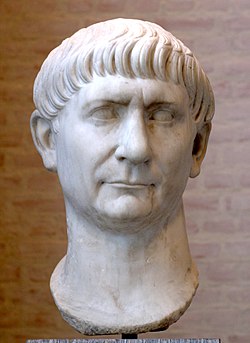 Roman Roman
Emperor who reigned from AD 98 until his death in AD 117. Born
Marcus Ulpius Traianus into a non-patrician
family in the
Hispania Baetica
province (modern day
Spain
), Trajan rose to prominence during the
reign of emperor
Domitian
, serving as a general in the
Roman army
along the
German frontier
, and successfully crushing the
revolt of
Antonius Saturninus
in 89. On September 18, 96,
Domitian was succeeded by
Marcus Cocceius Nerva
, an old and childless
senator who proved to be unpopular with the army. After a brief and tumultuous
year in power, a revolt by members of the
Praetorian Guard
compelled him to adopt the
more popular Trajan as his heir and successor. Nerva died on January 27, 98, and
was succeeded by his adopted son without incident.
As a civilian administrator, Trajan is best known for his
extensive public building program, which reshaped the city of
Rome and left multiple enduring landmarks such as
Trajan’s Forum
,
Trajan’s Market
and
Trajan’s Column
. It was as a military commander
however that Trajan celebrated his greatest
triumphs
. In 101, he launched a
punitive expedition
into the kingdom of
Dacia
against king
Decebalus
, defeating the Dacian army near
Tapae
in 102, and finally conquering Dacia
completely in 106. In 107, Trajan pushed further east and annexed the
Nabataean kingdom
, establishing the province of
Arabia Petraea
. After a period of relative
peace within the Empire, he launched his final campaign in 113 against
Parthia
, advancing as far as the city of
Susa in 116, and expanding the Roman Empire to its greatest extent.
During this campaign Trajan was struck by illness, and late in 117, while
sailing back to Rome, he died of a
stroke
on
August 9
, in the city of
Selinus
. He was
deified
by the Senate and his ashes were laid
to rest under
Trajan’s Column
. He was succeeded by his
adopted son (not having a biological heir)
Publius Aelius Hadrianus
—commonly known as
Hadrian.
As an emperor, Trajan’s reputation has endured – he is one of
the few rulers whose reputation has survived the scrutiny of nineteen centuries
of history. Every new emperor after him was honoured by the Senate with the
prayer felicior Augusto, melior Traiano, meaning “may he be luckier than
Augustus
and better than Trajan”. Among
medieval
Christian theologians, Trajan was
considered a
virtuous pagan
, while the 18th century
historian
Edward Gibbon
popularized the notion of the
Five Good Emperors
, of which Trajan was the
second.
Early life and rise to power
Trajan was born on September 18, 53 in the Roman province of
Hispania Baetica
(in what is now
Andalusia
in modern Spain), a province that was
thoroughly Romanized and called southern Hispania, in the city of
Italica
, where the
Italian
families were paramount. Of
Italian
stock himself, Trajan is frequently but
misleadingly designated the first provincial emperor.
Trajan was the son of
Marcia
and
Marcus Ulpius Traianus
, a prominent
senator
and general from the famous
Ulpia
gens.
Trajan himself was just one of many well-known Ulpii in a line that continued
long after his own death. His elder sister was
Ulpia Marciana
and his niece was
Salonina Matidia
. The
patria
of the Ulpii was
Italica
, in Spanish Baetica, where their
ancestors had settled late in the third century B.C. This indicates that the
Italian origin was paramount, yet it has recently been cogently argued that the
family’s ancestry was local, with Trajan senior actually a Traius who was
adopted into the family of the Ulpii.
As a young man, he rose through the ranks of the
Roman army
, serving in some of the most
contentious parts of the Empire’s frontier. In 76–77, Trajan’s father was
Governor
of
Syria
(Legatus
pro praetore Syriae), where Trajan himself remained as
Tribunus
legionis. Trajan was nominated as
Consul
and brought
Apollodorus of Damascus
with him to
Rome around 91. Along the
Rhine River
, he took part in the Emperor
Domitian
‘s wars while under Domitian’s
successor, Nerva
, who was unpopular with the army and
needed to do something to gain their support. He accomplished this by naming
Trajan as his adoptive son and successor in the summer of 97. According to the
Augustan History
, it was the future Emperor
Hadrian
who brought word to Trajan of his
adoption. When Nerva died on January 27, 98, the highly respected Trajan
succeeded without incident.
His
reign
The new Roman emperor was greeted by the people of Rome with
great enthusiasm, which he justified by governing well and without the
bloodiness that had marked Domitian’s reign. He freed many people who had been
unjustly imprisoned by Domitian and returned a great deal of private property
that Domitian had confiscated; a process begun by Nerva before his death. His
popularity was such that the
Roman Senate
eventually bestowed upon Trajan
the honorific
of optimus, meaning “the
best”.
Dio Cassius
, sometimes known as Dio, reveals
that Trajan drank heartily and was
involved with boys
. “I know, of course, that he
was devoted to boys and to wine, but if he had ever committed or endured any
base or wicked deed as the result of this, he would have incurred censure; as it
was, however, he drank all the wine he wanted, yet remained sober, and in his
relation with boys he harmed no one.” This sensibility was one that influenced
his governing on at least one occasion, leading him to favour the king of Edessa
out of appreciation for his handsome son: “On this occasion, however,
Abgarus
, induced partly by the persuasions of
his son Arbandes, who was handsome and in the pride of youth and therefore in
favour with Trajan, and partly by his fear of the latter’s presence, he met him
on the road, made his apologies and obtained pardon, for he had a powerful
intercessor in the boy.”
Dacian
Wars
It was as a military commander that Trajan is best known to
history, particularly for his conquests in the
Near East
, but initially for the two wars
against Dacia
— the reduction to client kingdom
(101-102), followed by actual incorporation to the Empire of the trans-Danube
border kingdom of Dacia—an area that had troubled Roman thought for over a
decade with the unfavourable (and to some, shameful) peace negotiated by
Domitian
‘s ministers In the first war c.
March–May 101, he launched a vicious attack into the kingdom of
Dacia
with four legions, crossing to the
northern bank of the
Danube River
on a stone bridge he had built,
and defeating the Dacian army near or in a
mountain pass
called
Tapae
(see
Second Battle of Tapae
). Trajan’s troops were
mauled in the encounter, however and he put off further campaigning for the year
to heal troops, reinforce, and regroup.
During the following winter, King
Decebalus
launched a counter-attack across the
Danube
further downstream, but this was
repulsed. Trajan’s army advanced further into Dacian territory and forced King
Decebalus to submit to him a year later, after Trajan took the Dacian
capital/fortress of
Sarmizegethusa
. The Emperor Domitian had
campaigned against
Dacia from 86 to 87
without securing a decisive
outcome, and Decebalus had brazenly flouted the terms of the peace (89 AD) which
had been agreed on conclusion of this campaign.
Trajan now returned to Rome in triumph and was granted the
title Dacicus Maximus. The victory was celebrated by the
Tropaeum Traiani
. Decebalus though, after being
left to his own devices, in 105 undertook an invasion against Roman territory by
attempting to stir up some of the tribes north of the river against her.
Trajan took to the field again and after building with the
design of
Apollodorus of Damascus
his
massive bridge over the Danube
, he conquered
Dacia completely in 106. Sarmizegethusa was destroyed,
Decebalus
committed
suicide
, and his severed head was exhibited in
Rome on the steps leading up to the
Capitol
. Trajan built a new city, “Colonia
Ulpia Traiana Augusta Dacica Sarmizegetusa”, on another site than the previous
Dacian Capital, although bearing the same full name, Sarmizegetusa. He resettled
Dacia with Romans and annexed it as a province of the Roman Empire. Trajan’s
Dacian campaigns benefited the Empire’s finances through the acquisition of
Dacia’s gold mines. The victory is celebrated by
Trajan’s Column
.
Expansion
in the East
At about the same time
Rabbel II Soter
, one of Rome’s client kings,
died. This event might have prompted the annexation of the
Nabataean kingdom
, although the manner and the
formal reasons for the annexation are unclear. Some epigraphic evidence suggests
a military operation, with forces from
Syria
and
Egypt
. What is clear, however, is that by 107,
Roman legions were stationed in the area around
Petra
and
Bostra
, as is shown by a papyrus found in
Egypt. The empire gained what became the province of
Arabia Petraea
(modern southern
Jordan
and north west
Saudi Arabia
).
Period
of peace
The next seven years, Trajan ruled as a civilian emperor, to
the same acclaim as before. It was during this time that he corresponded with
Pliny the Younger
on the subject of how to deal
with the
Christians
of
Pontus
, telling Pliny to leave them alone
unless they were openly practicing the religion. He built several new buildings,
monuments and roads in
Italia
and his native
Hispania
. His magnificent complex in Rome
raised to commemorate his victories in
Dacia
(and largely financed from that
campaign’s loot)—consisting of a
forum
,
Trajan’s Column
, and Trajan’s Market still
stands in Rome today. He was also
a prolific builder of triumphal arches
, many of
which survive, and rebuilder of roads (Via
Traiana and
Via Traiana Nova
).
One notable act of Trajan was the hosting of a three-month
gladiatorial
festival in the great
Colosseum
in Rome (the precise date of this
festival is unknown). Combining chariot racing, beast fights and close-quarters
gladiatorial bloodshed, this gory spectacle reputedly left 11,000 dead (mostly
slaves and criminals, not to mention the thousands of ferocious beasts killed
alongside them) and attracted a total of five million spectators over the course
of the festival.
Another important act was his formalisation of the
Alimenta, a welfare program that helped orphans and poor children throughout
Italy. It provided general funds, as well as food and subsidized education. The
program was supported initially by funds from the Dacian War, and then later by
a combination of estate taxes and philanthropy.[13].
Although the system is well documented in literary sources and contemporary
epigraphy, its precise aims are controversial and have generated considerable
dispute between modern scholars: usually, it’s assumed that the programme
intended to bolster citzen numbers in Italy. However, the fact that it was
subsidized by means of interest payments on loans made by landowners restricted
it to a small percentage of potential welfare recipients (Paul
Veyne has assumed that, in the city of
Veleia
, only one child out of ten was an actual
beneficiary) – therefore, the idea, advanced by
Moses I. Finley
, that the whole scheme was at
most a form of random charity, a mere imperial benevolence[14].
Maximum
extent of the Empire

The extent of the Roman Empire under Trajan (117)
In 113, he embarked on his last campaign, provoked by
Parthia
‘s decision to put an unacceptable king
on the throne of Armenia
, a kingdom over which the two great
empires had shared
hegemony
since the time of
Nero some fifty years earlier. Some modern historians also attribute
Trajan’s decision to wage war on Parthia to economic motives: to control, after
the annexation of Arabia, Mesopotamia and the coast of the Persian Gulf, and
with it the sole remaining receiving-end of the Indian trade outside Roman
control – an attribution of motive other historians find absurd, as seeing a
commercial motive in a campaign triggered by the lure of territorial annexation
and prestige – by the way, the only motive for Trajan’s actions ascribed by Dio
Cassius in his description of the events. Other modern historians, however,
think that Trajan’s original aim was quite modest: to assure a more defensible
Eastern frontier for the Roman Empire, crossing across Northern Mesopotamia
along the course of the river
Khabur
in order to offer cover to a Roman
Armenia.
Trajan marched first on Armenia, deposed the
Parthian-appointed king (who was afterwards murdered while kept in the custody
of Roman troops in an unclear incident) and annexed it to the Roman Empire as a
province, receiving in passing the acknowledgement of Roman hegemony by various
tribes in the Caucasus and on the Eastern coast of the Black Sea – a process
that kept him busy until the end of 114].
The cronology of subsequent events is uncertain, but it’s generally believed
that early in 115 Trajan turned south into the core Parthian hegemony, taking
the Northern Mesopotamian cities of
Nisibis
and
Batnae
and organizing a province of
Mesopotamia
in the beginning of 116, when coins
were issued announcing that Armenia and Mesopotamia had been put under the
authority of the Roman people.
In early 116, however, Trajan began to toy with the conquest
of the whole of Mesopotamia, an overambitious goal that eventually backfired on
the results of his entire campaign: One Roman division crossed the
Tigris
into
Adiabene
, sweeping South and capturing
Adenystrae
; a second followed the river South,
capturing Babylon
; while Trajan himself sailed down the
Euphrates
, then dragged his fleet overland into
the Tigris, capturing
Seleucia
and finally the Parthian capital of
Ctesiphon
. He continued southward to the
Persian Gulf
, receiving the submission of
Athambelus, the ruler of
Charax
, whence he declared Babylon a new
province of the Empire, sent the Senate a laurelled letter declaring the war to
be at a close and lamented that he was too old to follow in the steps of
Alexander the Great
and reach the distant
India
itself. A province of
Assyria
was also proclaimed, apparently
covering the territory of Adiabene, as well as some measures seem to have been
considered about the fiscal administration of the Indian trade.
However, as Trajan left the Persian Gulf for Babylon – where
he intended to offer sacrifice to Alexander in the house where he had died in
323 B.C.- a sudden outburst of Parthian resistance, led by a nephew of the
Parthian king, Sanatrukes, imperilled Roman positions in Mesopotamia and
Armenia, something Trajan sought to deal with by forsaking direct Roman rule in
Parthia proper, at least partially: later in 116, after defeating a Parthian
army in a battle where Sanatrukes was killed and re-taking Seleucia, he formally
deposed the Parthian king
Osroes I
and put his own puppet ruler
Parthamaspates
on the throne. That done, he
retreated North in order to retain what he could of the new provinces of Armenia
and Mesopotamia.
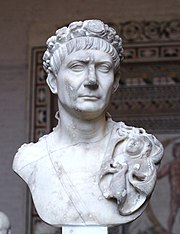
Bust of Trajan,
Glyptothek
,
Munich
.
It was at this point that Trajan’s health started to fail
him. The fortress city of
Hatra
, on the
Tigris
in his rear, continued to hold out
against repeated Roman assaults. He was personally present at the
siege
and it is possible that he suffered a
heat stroke while in the blazing heat. Shortly afterwards, the
Jews inside the Eastern Roman Empire rose up in rebellion once more,
as did the people of Mesopotamia. Trajan was forced to withdraw his army in
order to put down the revolts. Trajan saw it as simply a temporary setback, but
he was destined never to command an army in the field again, turning his Eastern
armies over to the high ranking legate and governor of Judaea,
Lusius Quietus
, who in early 116 had been in
charge of the Roman division who had recovered Nisibis and
Edessa
from the rebels; Quietus was promised
for this a consulate in the following year – when he was actually put to death
by Hadrian
, who had no use for a man so committed
to Trajan’s aggressive policies.
Early in 117, Trajan grew ill and set out to sail back to
Italy. His health declined throughout the spring and summer of 117, something
publicy acknowledged by the fact that a bronze bust displayed at the time in the
public baths of
Ancyra
showed him clearly aged and edemaciated.
By the time he had reached Selinus in
Cilicia
which was afterwards called
Trajanopolis, he suddenly died from
edema
on August 9. Some say that he had adopted
Hadrian
as his successor, but others that it
was his wife
Pompeia Plotina
who hired someone to
impersonate him after he had died.
Hadrian
, upon becoming ruler, recognized the
abandonment of Mesopotamia and restored Armenia – as well as
Osroene
– to the Parthian hegemony under Roman
suzerainty – a telling sign the Roman Empire lacked the means for pursuing
Trajan’s overambitious goals. However, all the other territories conquered by
Trajan were retained. Trajan’s ashes were laid to rest underneath Trajan’s
column, the monument commemorating his success.
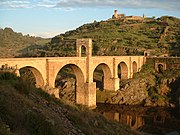
The
Alcántara Bridge
, widely hailed as
a masterpiece of
Roman engineering
.
Building
activities
Trajan was a prolific builder in Rome and the provinces, and
many of his buildings were erected by the gifted architect
Apollodorus of Damascus
. Notable structures
include
Trajan’s Column
,
Trajan’s Forum
,
Trajan’s Bridge
,
Alcántara Bridge
, and possibly the
Alconétar Bridge
. In order to build his forum
and the adjacent brick market that also held his name Trajan had vast areas of
the surrounding hillsides leveled.
Trajan’s
legacy
Unlike many lauded rulers in history, Trajan’s reputation has
survived undiminished for nearly nineteen centuries.
Ancient sources on Trajan’s personality and accomplishments
are unanimously positive. Pliny the younger, for example, celebrates Trajan in
his panegyric as a wise and just emperor and a moral man.
Dio Cassius
admits Trajan had vices like heavy
drinking and sexual involvement with boys, but added that he always remained
dignified and fair. The
Christianisation
of Rome resulted in further
embellishment of his legend: it was commonly said in
medieval
times that
Pope Gregory I
, through divine intercession,
resurrected Trajan from the dead and baptized him into the Christian faith. An
account of this features in the
Golden Legend
.
Theologians, such as
Thomas Aquinas
, discussed Trajan as an example
of a virtuous pagan. In
the Divine Comedy
,
Dante
, following this legend, sees the spirit
of Trajan in the Heaven of
Jupiter
with other historical and mythological
persons noted for their justice.
He also features in
Piers Plowman
. An episode, referred to as
the
justice of Trajan
was reflected in several art
works.
In the 18th Century King
Charles III of Spain
comminsioned
Anton Raphael Mengs
to paint The Triumph of
Trajan on the ceiling of the banqueting-hall of the
Royal Palace of Madrid
– considered among the
best work of this artist.
“Traian” is used as a male first name in present-day
Romania
– among others, that of the country’s
incumbent president,
Traian Băsescu
.
|











 Roman
Roman



